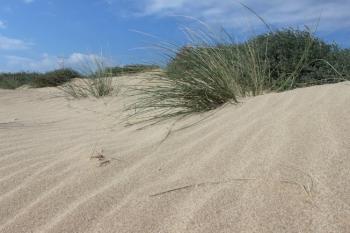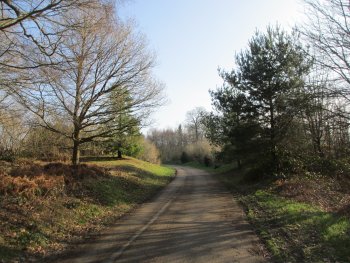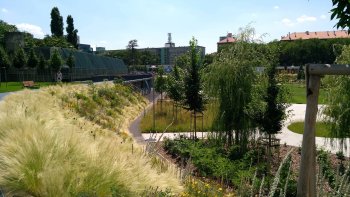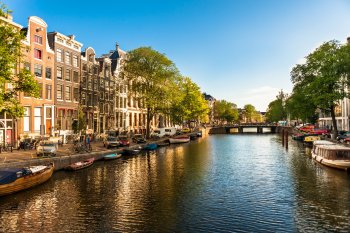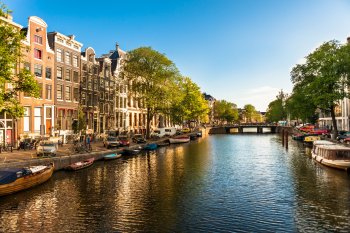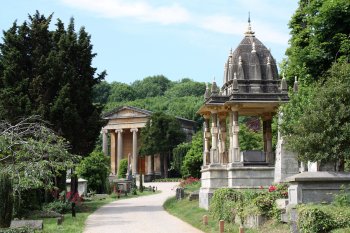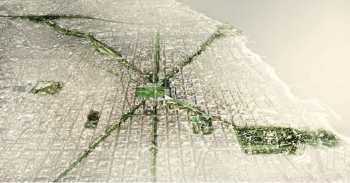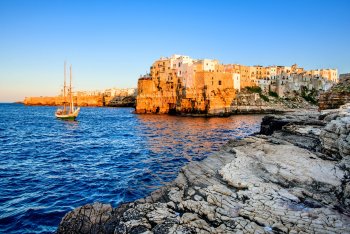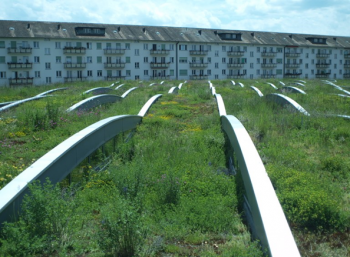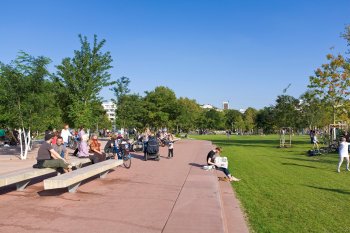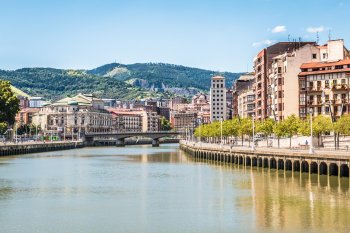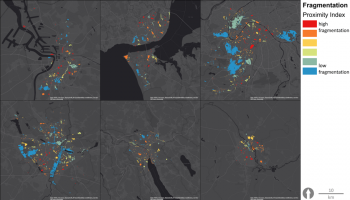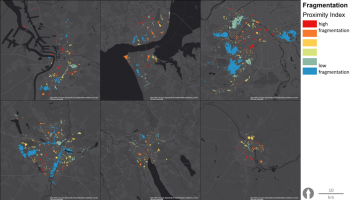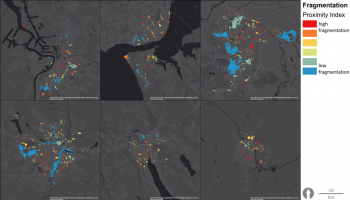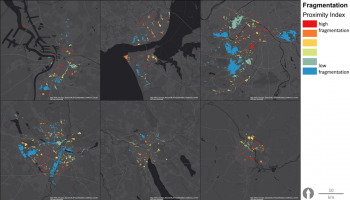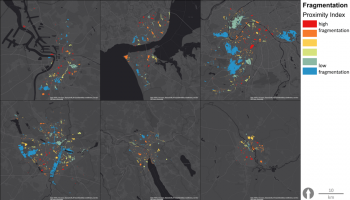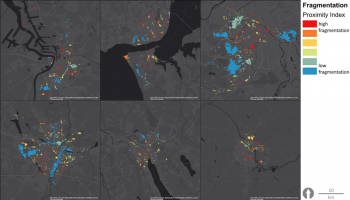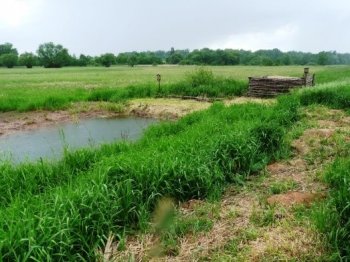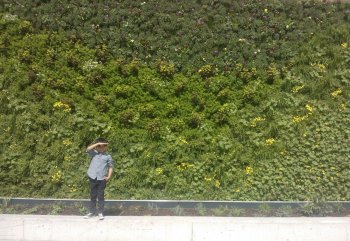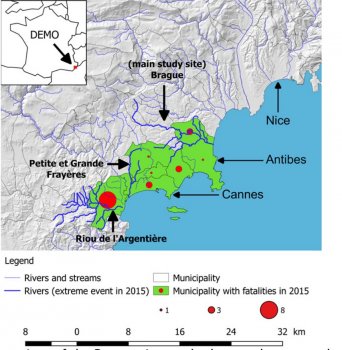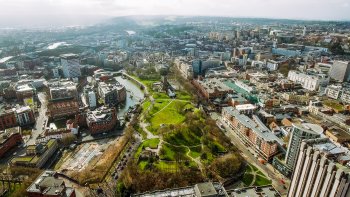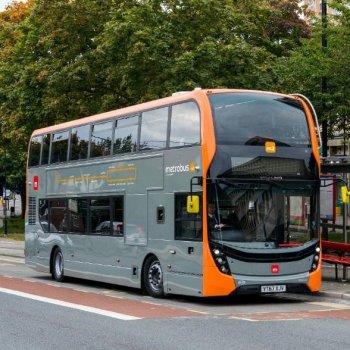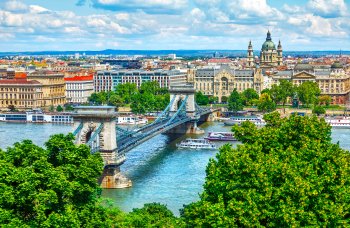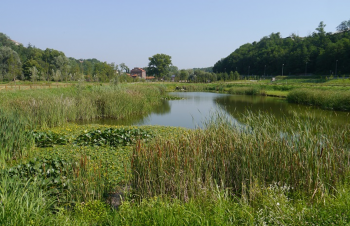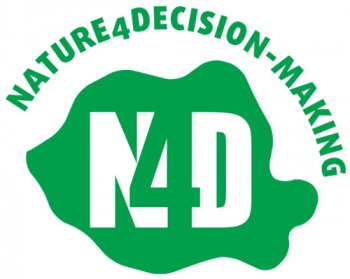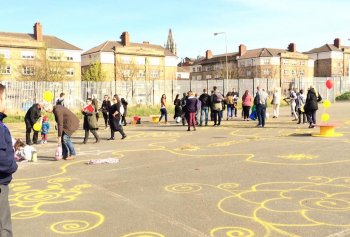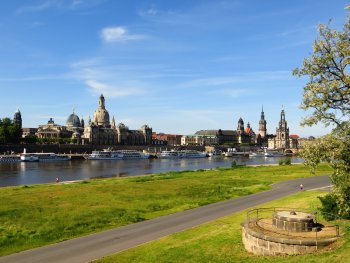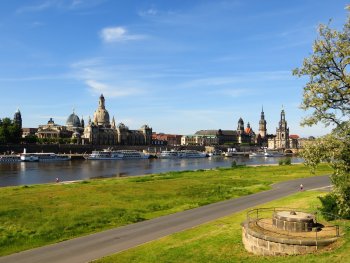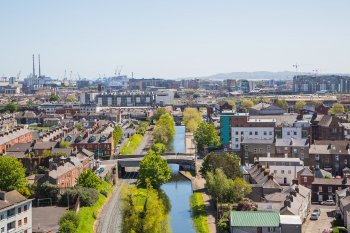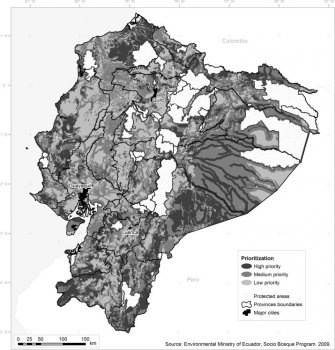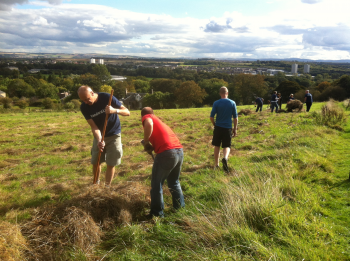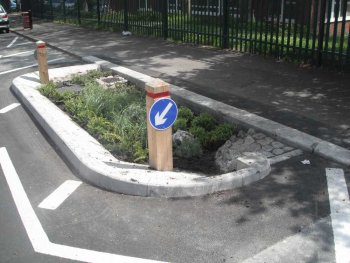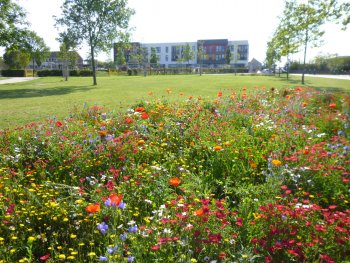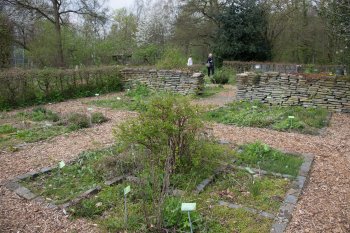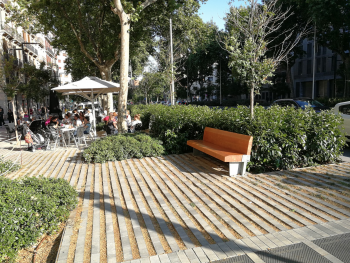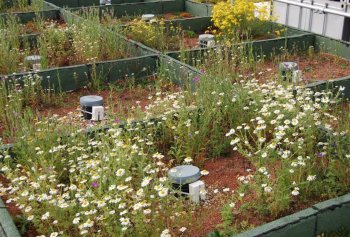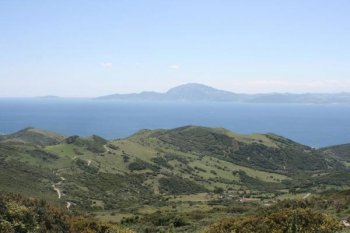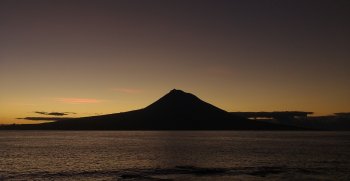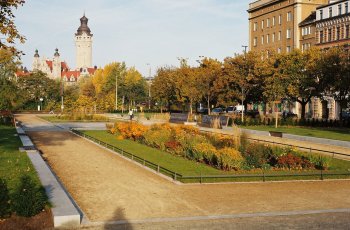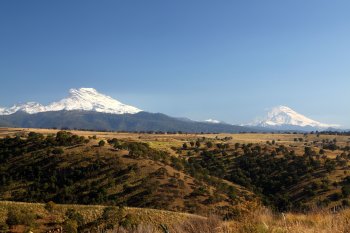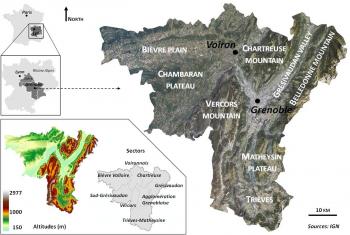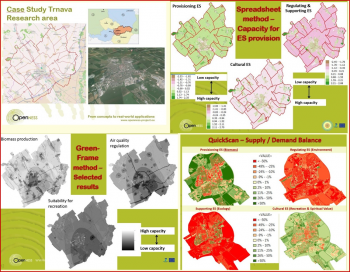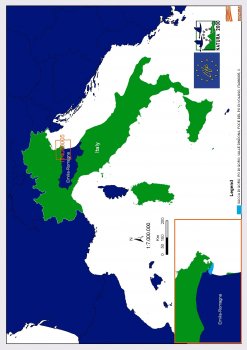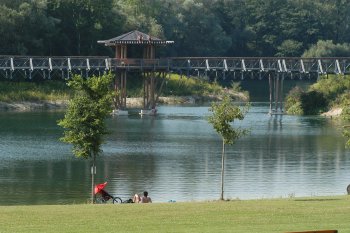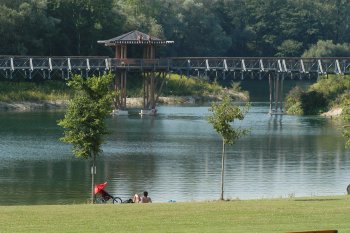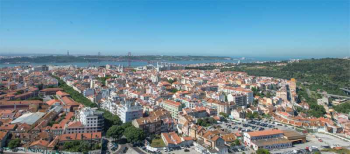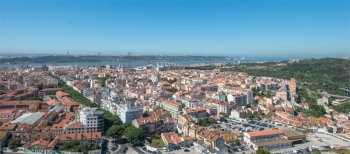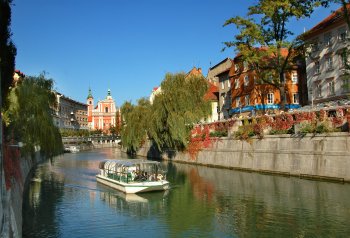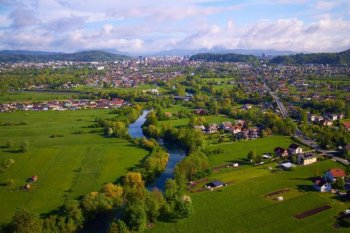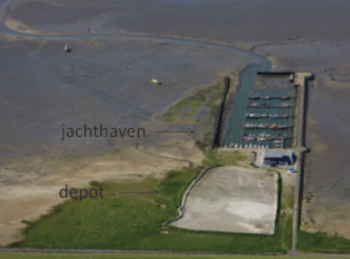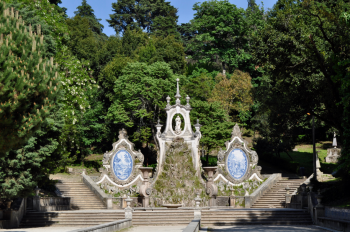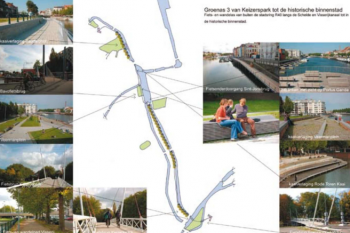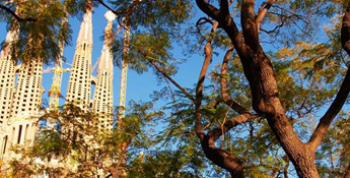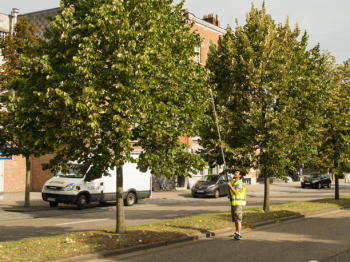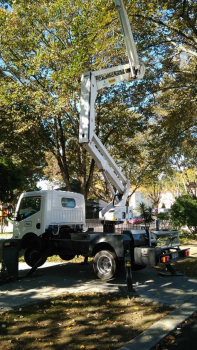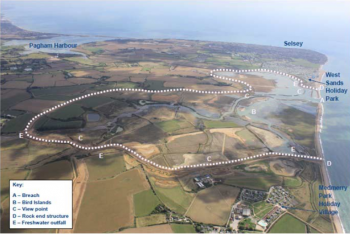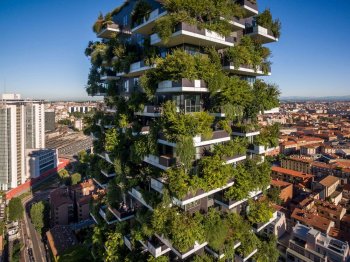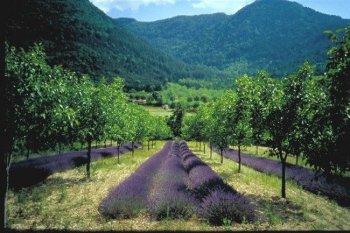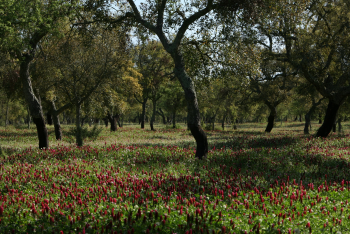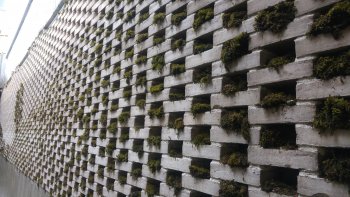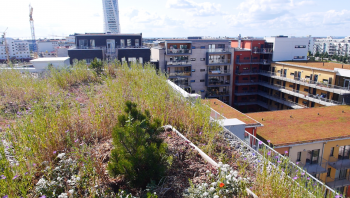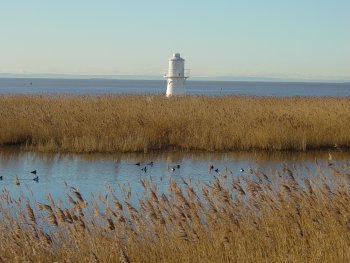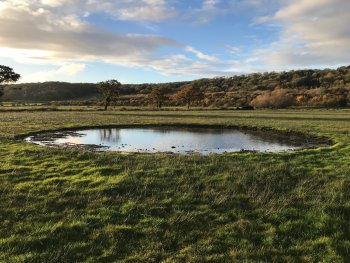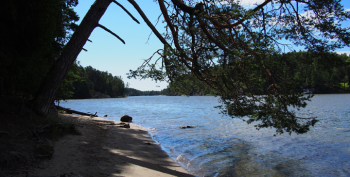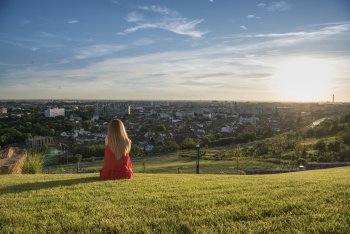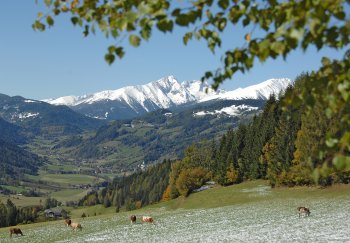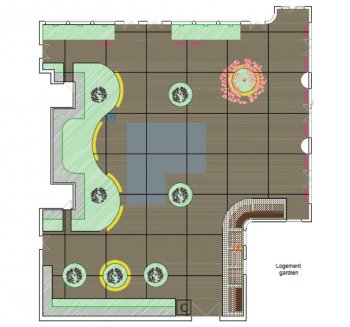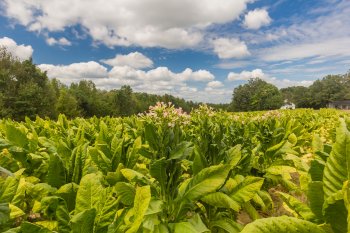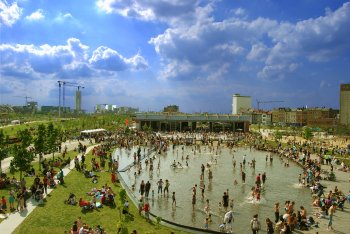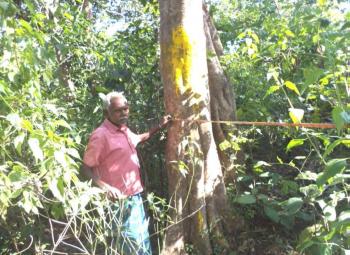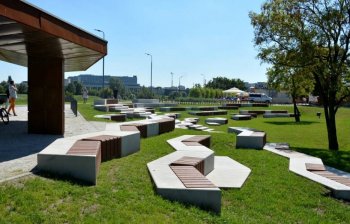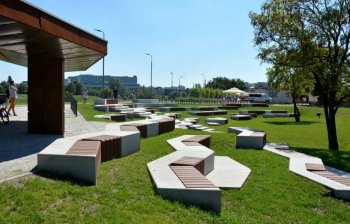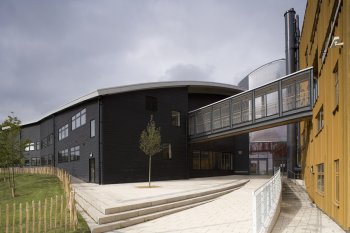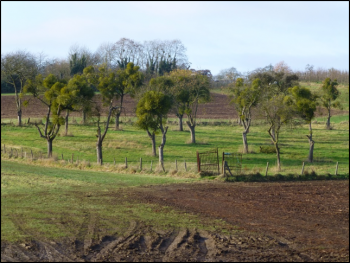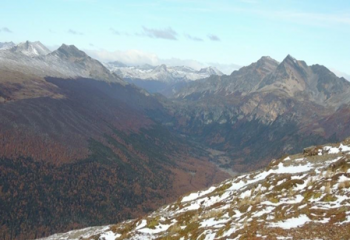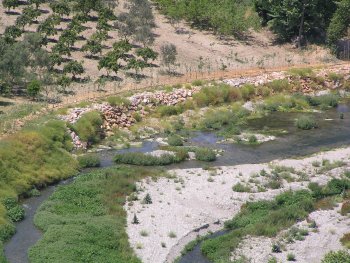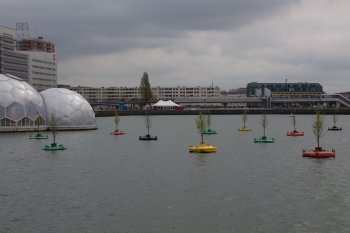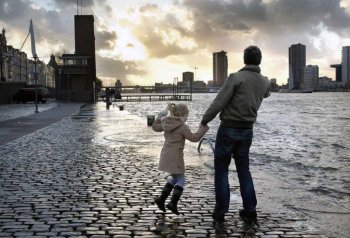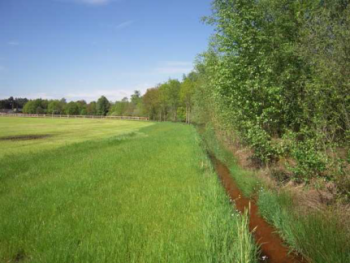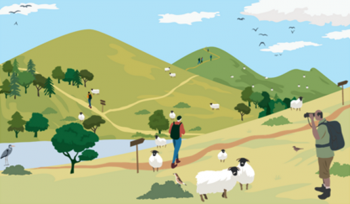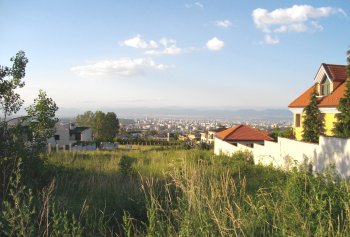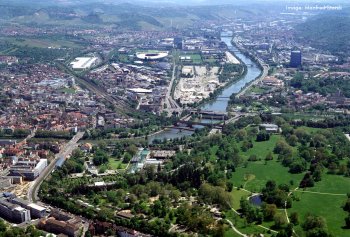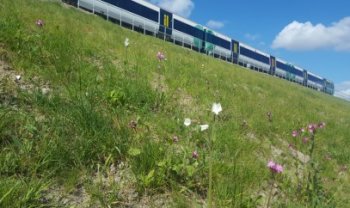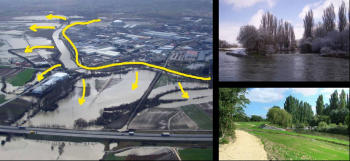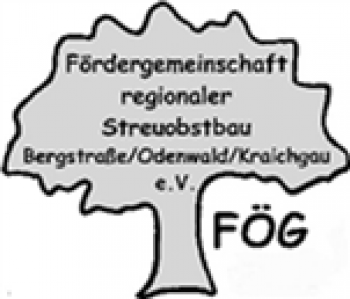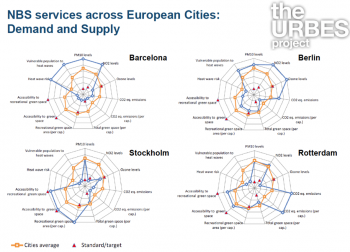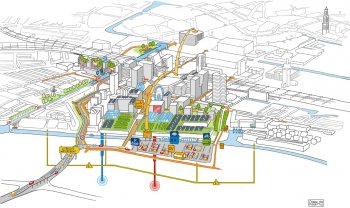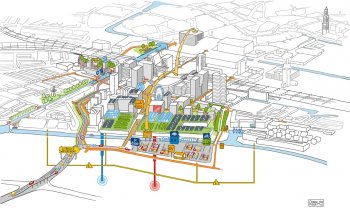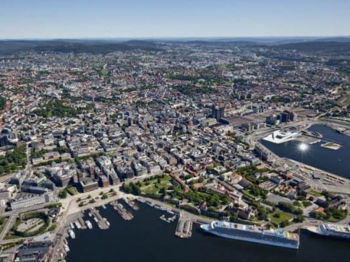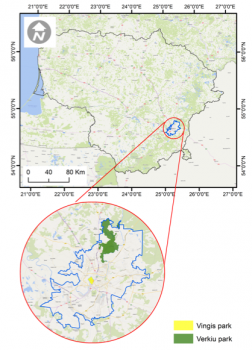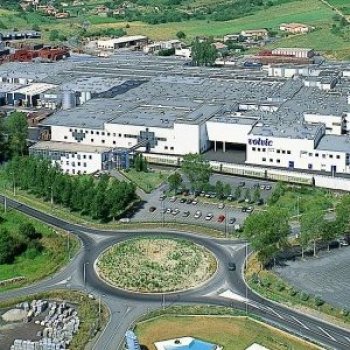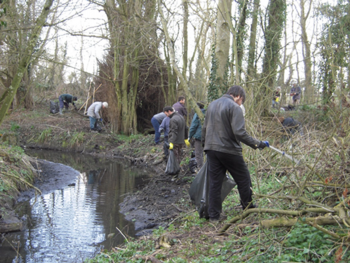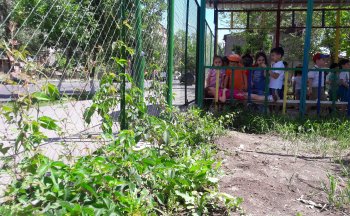Constructing and maintaining semi-fixed dunes on heavily used urban beaches to optimize the flows of ecosystem services, through collaboration with administrations and stakeholders. Dunes play a central role in coastal defence and protection against sea level rise linked to climatic change. Stakeholder mapping and social research will be used to learn how to shape social attitudes to make the year-round intensive recreational use of beaches compatible with the protection of the dunes.
To mitigate the development of a 3.2km bypass by building a green land bridge to enable the historic West drive to be reinstated on its original line and provide landscape and habitat connectivity.
The Strategy on adaptation to negative effects of climate change within the territory of Bratislava the Capital of the Slovak Republic (2014) and the forthcoming Action plan for adaptation to climate change in Bratislava 2017-2020 focus on the following goals: assess the vulnerability of the city to most relevant climate change hazards, mainstream adaptation planning into policies, being a climate neutral city, support awareness raising and partnership in climate change adaptation and provide a framework for monitoring and evaluation of the adaptation process.
Climate change challenges in...
The 2010 city-region plan ‘Structural Vision: Amsterdam 2040’, managed by the Department of Physical Planning, set the investment and project ambitions for the period 2010-2040. The strategy seeks to fulfil the vision of a creative and varied city, with an integrated public transport network, high quality urban planning, and investment in recreational green spaces, water and renewable energies. Water-related hazards, such as floods and storm surges, are managed at all levels - city, regional and national. The ‘Agenda Groen 2015-2018’ (Green Agenda 2015-2018) includes specific ‘Nature Based...
The 2010 city-region plan ‘Structural Vision: Amsterdam 2040’, managed by the Department of Physical Planning, set the investment and project ambitions for the period 2010-2040. The strategy seeks to fulfil the vision of a creative and varied city, with an integrated public transport network, high quality urban planning, and investment in recreational green spaces, water and renewable energies. Water-related hazards, such as floods and storm surges, are managed at all levels - city, regional and national. The ‘Agenda Groen 2015-2018’ (Green Agenda 2015-2018) includes specific ‘...
To restore a Victorian cemetery from a state of neglect to provide a community green space, whilst maintaining and celebrating the heritage of the site as well as its conservation and ecological value.
The objective of the catalogue of actions set out in the Green Infrastructure and Biodiversity Plan is to implement a strategy for improving existing green heritage and for preserving and enhancing Barcelona’s biodiversity to provide the inhabitants of Barcelona with many ecosystem services.
The overall objectives of the Bari city authorities are to improve urban quality, reduce the urban heat island effect and manage storm water.
Improving green areas and their functions is a crucial part of achieving this goal and is addressed by several plans within Bari’s multi-level planning system. This multi-level planning consists of:
the city itself, which is responsible for statutory land-use planning;
the metropolitan area of Bari, which has powers only for strategic planning;
the Apulia Region, which is responsible for overarching plans in areas such as landscape, regional...
By 2100, under a high greenhouse emissions scenario, the temperature is projected to increase by about 4.5 ºC in comparison to the 1990s. This means that every second summer will be as hot or even hotter than the temperatures reached during the 2003 heat wave which caused severe loss of life across Europe. Extreme precipitation events are likely to increase in frequency and severity. Green roofs were found to offer opportunities to combine energy saving, climate change mitigation and adaptation, and biodiversity objectives. In densely built-up areas where providing extensive parks and...
Berlin has approximately 40 % of green (parks, forests etc.) and blue (rivers, channels, lakes, ponds, etc.) areas within its borders. It aims to create connectivity across the city and a ‘green belt’ as a border boundary for urban growth and a protection against urban sprawl.
Berlin has a specific multi-level administrative structure which determines how different layers of government interact and how competences are distributed. The city of Berlin (Stadt Berlin) fulfils both functions of the municipal and the state level (Land) in the German federal system. It is subdivided into districts (...
The city is currently revising its urban Master Plan, which aims to make Bilbao i) an example for other cities around the world; ii) a city in continuous renewal; iii) a sustainable city; and iv) a socially balanced city.
Extreme climate events in the recent – and not-so recent – past have shown that Bilbao is more vulnerable than most other cities. This realisation prompted scientific research into how the city could plan for sustainable development and prepare itself for further climate-change risks.
This resulted in the city authorities drawing up a list of the following priorities for...
The main objective of our BIOVEINS proposal is to use functional diversity (FD) to highlight the mechanisms underpinning the link between GBI, taxonomic diversity (TD) and ecosystem services (ESs) provisioning, and to provide, together with local stakeholders, the ecological and interdisciplinary knowledge to identify the critical features of GBI, to guide the establishment, management and restoration of GBI, and to mitigate the effects of major urban global challenges, like habitat fragmentation, air pollution, and urban heat island.
This main objective will be accomplished by several...
The main objective of our BIOVEINS proposal is to use functional diversity (FD) to highlight the mechanisms underpinning the link between GBI, taxonomic diversity (TD) and ecosystem services (ESs) provisioning, and to provide, together with local stakeholders, the ecological and interdisciplinary knowledge to identify the critical features of GBI, to guide the establishment, management and restoration of GBI, and to mitigate the effects of major urban global challenges, like habitat fragmentation, air pollution, and urban heat island.
This main objective will be accomplished by several...
The main objective of our BIOVEINS proposal is to use functional diversity (FD) to highlight the mechanisms underpinning the link between GBI, taxonomic diversity (TD) and ecosystem services (ESs) provisioning, and to provide, together with local stakeholders, the ecological and interdisciplinary knowledge to identify the critical features of GBI, to guide the establishment, management and restoration of GBI, and to mitigate the effects of major urban global challenges, like habitat fragmentation, air pollution, and urban heat island.
This main objective will be accomplished by several...
The main objective of our BIOVEINS proposal is to use functional diversity (FD) to highlight the mechanisms underpinning the link between GBI, taxonomic diversity (TD) and ecosystem services (ESs) provisioning, and to provide, together with local stakeholders, the ecological and interdisciplinary knowledge to identify the critical features of GBI, to guide the establishment, management and restoration of GBI, and to mitigate the effects of major urban global challenges, like habitat fragmentation, air pollution, and urban heat island.
This main objective will be accomplished by several...
The main objective of our BIOVEINS proposal is to use functional diversity (FD) to highlight the mechanisms underpinning the link between GBI, taxonomic diversity (TD) and ecosystem services (ESs) provisioning, and to provide, together with local stakeholders, the ecological and interdisciplinary knowledge to identify the critical features of GBI, to guide the establishment, management and restoration of GBI, and to mitigate the effects of major urban global challenges, like habitat fragmentation, air pollution, and urban heat island.
This main objective will be accomplished by several...
The main objective of our BIOVEINS proposal is to use functional diversity (FD) to highlight the mechanisms underpinning the link between GBI, taxonomic diversity (TD) and ecosystem services (ESs) provisioning, and to provide, together with local stakeholders, the ecological and interdisciplinary knowledge to identify the critical features of GBI, to guide the establishment, management and restoration of GBI, and to mitigate the effects of major urban global challenges, like habitat fragmentation, air pollution, and urban heat island.
This main objective will be accomplished by several...
The main objective of our BIOVEINS proposal is to use functional diversity (FD) to highlight the mechanisms underpinning the link between GBI, taxonomic diversity (TD) and ecosystem services (ESs) provisioning, and to provide, together with local stakeholders, the ecological and interdisciplinary knowledge to identify the critical features of GBI, to guide the establishment, management and restoration of GBI, and to mitigate the effects of major urban global challenges, like habitat fragmentation, air pollution, and urban heat island.
This main objective will be accomplished by several...
The main objective of our BIOVEINS proposal is to use functional diversity (FD) to highlight the mechanisms underpinning the link between GBI, taxonomic diversity (TD) and ecosystem services (ESs) provisioning, and to provide, together with local stakeholders, the ecological and interdisciplinary knowledge to identify the critical features of GBI, to guide the establishment, management and restoration of GBI, and to mitigate the effects of major urban global challenges, like habitat fragmentation, air pollution, and urban heat island.
This main objective will be accomplished by several...
34 case studies were planned by the H2020 PEGASUS project in different farming and forest systems and along the supply chain in 10 EU countries, to:
examine the issues faced in ensuring effective provision of public goods/ecosystem services from farming & forest activities; and
find solutions to enable the economic social and environmental sustainability of the EU’s farmed & forest areas.
To convert an energy intensive system of heating, cooling and ventilation, which was poorly maintained and controlled into a modern, green, sustainable development while adhering to stringent rail standards.
The public perception of ecosystems (e.g. forests, including possibly protecting ones) is strongly worsened following floods with massive wood jams. This case study aims at performing a comprehensive and in-depth analysis of a Mediterranean catchment to assess NbS benefits, dis-benefits and co-benefits and ways to optimize them.
All of the challenges identified in the Bristol Development Framework Core Strategy (1) concern areas which would benefit from NbS. Furthermore, the 20:20 plan – Bristol’s Sustainable City Strategy (2) – has identified climate change as one of three key challenges. It acknowledges the potential for green infrastructure, such as trees, green walls and roofs, to minimise and mitigate the urban heat island effect, while Sustainable Urban Drainage Systems (SUDS) are seen as an important part of flood management. Bristol’s Parks and Green Spaces Strategy (3) includes a 20-year investment programme...
To create a green, quick, frequent and reliable bus service and improve walking and cycling opportunities which will ultimately help to reduce traffic congestion, noise and air pollution.
To address these challenges, Budapest has drafted several strategic documents, in which NbS are promoted as a way to improve the environment, sustainability, and quality of life. These documents include:
The Budapest 2030 Long-Term Urban Development Concept. This strategic document aims to protect and increase green areas, so as to ensure ecological connectivity and develop walking and cycling corridors. It also promotes greater investment in brownfield sites, the prevention of urban sprawl, and 'smart' city development.
The Integrated Urban Development Strategy 2020. This strategy...
Testing the feasibility of a green infrastructure, instead of a traditional grey infrastructure, to treat sewage overflows, and investigating the multiple benefits that the green infrastructure provides and its relevance for water management.
The Project “Demonstrating and promoting natural values, to support the decision-making process in Romania” (N4D) was developed based on folowing activities: A1. institutional infrastructure development; A2. Development of the ecosystem mapping and assessment framework in Romania; A3. Data analysis and management under the MAES process; A4. Biophysical mapping and assessment of ecosystems and of their services; A5. Project promotion; A6. Knowledge exchange with the neighbouring countries and with Norway, as the country providing the Project financing.
Activating community based projects in a deprived neighbourhood, Mountjoy Square.
The landscape plan, which is currently under development following the incorporation into the city of some surrounding areas, is intended to bring about a compact city, accommodating further development within the existing borders, and including a network of functional green spaces. The draft version, which underwent a public and stakeholder consultation process in 2015, provides detailed indications for future development and also seeks changes to existing planning documents (Dresden, 2017a), with a view to protecting and enhancing green networks and so ensure air and water quality, reduce...
The landscape plan, which is currently under development following the incorporation into the city of some surrounding areas, is intended to bring about a compact city, accommodating further development within the existing borders, and including a network of functional green spaces. The draft version, which underwent a public and stakeholder consultation process in 2015, provides detailed indications for future development and also seeks changes to existing planning documents (Dresden, 2017a), with a view to protecting and enhancing green networks and so ensure air and water quality,...
In its 2016-2022 Development Plan the city has set out a vision for a ‘Sustainable, Resilient Dublin based on economy, environment and equity’ (1). The Development Plan’s principles for green infrastructure include sustainable buildings which should use ‘sustainable energy technologies and innovative design solutions such as living walls, roofs as well as solar panels’. NbS could help address climate change, environmental infrastructure, green infrastructure, open spaces and recreation, cultural heritage and sustainable communities and neighbourhoods (1). For example, sustainable urban...
Connected we're a living city.
To strengthen connectivity between resources in terms of people, space, knowledge, and expertise. To make clear the "What" that exists, to represent the "Who" and reveal the "How" of connecting to resources -creating a more resilient city in which resources flow to communities that require them most.
Conserve native forests and other native ecosystems to protect their ecological, economic, cultural and spiritual values.
Significantly reduce deforestation and associated GHG emissions.
Improve the well-being of farmers, indigenous communities and other groups living in the country’s rural areas
Key documents for green space and NbS at local level are the Local Development Plan and the Open Space Strategy. The Local Development Plan seeks to protect and enhance the environment and address the challenge of climate change. This will be partly achieved by using new development projects to enhance the green network. The Plan also identifies areas for conservation, and the different functions and benefits of urban green space are considered in terms of their contribution to the environment as well as their social and economic value.
The CEC’s Open Space Strategy seeks to address the main...
To reduce the flood risk, calm traffic and increase community involvement and awareness of sustainable urban drainage systems. To improve water quality in the River Trym.
To regenerate a brown site to develop 150 new homes, an improved park area and a BREEAM outstanding green business park. To deliver high quality jobs, family housing and a better green space.
To improve the public realm of a neglected and poorly accessible square.
Genk’s multi-annual strategic plan for 2014-19 is a response to the closure of the Ford car manufacturing company. The main objective of the plan has been to use Genk’s natural and human capital for sustainable value creation. Nature-based solutions are an integral part of the plan, used to create blue-green connections (top-down approach) and promote social inclusion (bottom-up approach).
The central Uzbek government needed to be convinced that investments in the Amu Darya delta would make social, ecological and economic sense. Ecosystem services of the delta were valued for three situations: the situation before degradation, the present degraded and the potential restored situation.
The area surrounding the confluence of the north and south branches of Thornton Creek (Seattle) experiences storm water-related flooding more often than other areas. A cost-benefit analysis, which incorporated ecosystem services values, aimed at identifying the best cost-benefit ratio among three possible options. The assessment results were intended to inform the decision of the choice of a project option.
Removing sediment from reservoirs is an important part of the costs of hydro-power generation. Farmers adapt and diversify land-use, based on PES scheme with hydro-power company in Sumberjaya.
To create a sustainable service station which has minimal impact on its surroundings and is sensitive to surrounding environment of the Cotswolds (AONB).
To create a community allotment that anyone can visit and is accessible to people with physical and/or mental ill health.
To improve public space functionality and use, to increase access to green spaces for district residents (Eixample), to contribute to higher biodiversity in the city, and to promote more and different retail activity at the ground floor of buildings, so to rejuvenate/boost the local economy.
Innovative multifunctional green urban space on heavily sealed surfaces of an inner city location.
Boosting ecosystem service performance through green roof design in Barking Riverside.
Protecting areas to protect biodiversity: The IBRM is home to several remarkable protected sites, high biodiversity richness and an important cultural heritage. However, pressures from human activities in the area are threatening these distinct values. Our aim is to use diverse data plus stakeholder input to understand the social and ecological system and design a multifunctional network of areas – that allow conservation, exploitation and restoration - and identify ideal sites for restoring degraded freshwater, coastal and marine ecosystems.
Collaborating to halt declining biodiversity: Despite designation as a Marine Protected Area, biodiversity in the Faial-Pico Channel is falling. Our aim: to collaborate with local stakeholders and policy-makers and apply the AQUACROSS Assessment Framework to understand social and ecological aspects of the Channel, and identify actions to efficiently and equitably ensure the Channel’s long-run sustainability, balancing the objectives of commercial and recreational fishers, tourism operators, and other local stakeholders.
Mapping green and grey structures of Leipzig to understand in which urban structure types land-use pressures on urban green are higher / lower and analysing how political and governance strategies and instruments support the protection of green infrastructure and its ecosystem services.
The Volkswagen Group (the Group) is one of the world’s leading automobile manufacturers. The Group is comprised of twelve brands (Volkswagen Passenger Cars, Audi, SEAT, ŠKODA, Bentley, Bugatti, Lamborghini, Porsche, Ducati, Volkswagen Commercial Vehicles, Scania and MAN), operating 118 production plants in 20 countries across Europe and 11 countries in the Americas, Asia, and Africa.
The Group aims to create lasting value for the Company, its employees, and its shareholders, but also for the countries and regions in which they operate. This all-embracing view of sustainability is shared by...
Analysing future land use trajectories and their effects on networks of biodiversity and ecosystem services for the Grenoble urban area. It will offer a better knowledge of mechanisms underpinning ecosystem services as well as analysing trade-offs and synergies between biodiversity, critical ecosystem services and territorial management. Further it will facilitate appropriation of tools and concepts by stakeholders and support the integration of the complexity of ecological functioning into debates on territorial planning and management.
Develop and test usable methods for valuation selected ecosystem services at the local and regional level, and promote their incorporation into the spatial planning process and in the broader decision making process in Slovakia.
The overall objective is the long-term conservation of Natura 2000 habitats and species of a delta coastal lagoon, by means of an integrated management that exploits, instead to contrast, the dynamism of the lagoon and its constant sedimentary deposit.
The city’s Grünlandkonzept (green space strategy) provides detailed strategic indications for local land use and infrastructure planning (Stadt Linz, 2013). Enhancing and protecting urban green areas is seen as a way of increasing the city’s attractiveness, and will also form part of the upcoming transformation of the city harbour area. Linz AG, a holding company owned by the municipality, is planning to position the harbour on the Danube river as an important regional and international business location, inter alia by means of intensive greening for parts of the area...
The city’s Grünlandkonzept (green space strategy) provides detailed strategic indications for local land use and infrastructure planning (Stadt Linz, 2013). Enhancing and protecting urban green areas is seen as a way of increasing the city’s attractiveness, and will also form part of the upcoming transformation of the city harbour area. Linz AG, a holding company owned by the municipality, is planning to position the harbour on the Danube river as an important regional and international business location, inter alia by means of intensive greening for parts of the area (Masterplan Linzer Hafen...
Enhancing sustainable urbanization
Restoring ecosystems and their functions
Developing climate change mitigation
Developing climate change adaptation; improving risk management and resilience
Over the last few decades, Lisbon has lost a third of its residents (Green Surge: Lisbon case study) as a result of uncontrolled urban development (urban sprawl in the suburbs coupled with depopulation and decaying neighbourhoods in the historical centre). This has led to a deterioration of the quality of life in the city. It is currently facing challenges such as the ‘heat island effect’, floods, air...
To tackle these challenges, the city has taken a series of measures in the context of the Master Development Plan. The plan sets out guidelines and objectives for specific planning and local development. In particular, the municipal ecological structure takes into account ecological principles and the importance of preserving natural, forest, agricultural and cultural heritage. Together with the Biodiversity 2020 Strategy, the city also approved the Biodiversity Action Plan in 2016, putting implementation actions in the context of green infrastructure and climate change adaptation and...
Green engine of development, metropolitan region of knowledge.
The vision was developed by key stakeholders in the process of preparation of the Regional Development Programme for the period 2014 – 2020.The Ljubljana urban region will respect the natural and cultural environment and its carrying capacity and will build its future on knowledge, innovation, creativity and the synergy between all important players and sectors. The region will be a healthy, attractive and safe place for high-quality living. The overhauled transport infrastructure will be in line with sustainable mobility...
In the framework of "Vision Ljubljana 2025", the city has adopted several sustainability-oriented strategic documents, especially the:
Urban Master Plan (83% of all city development is directed towards renewing existing developed areas and brownfields). This is the most important planning instrument for green spaces in the city.
Environment Protection Programme 2014-20, aiming to protect and enhance the natural environment in the city.
The Greater London Authority (GLA) participants in the BRIDGE FP7 project identified the primary planning goals for the Central Activities Zone (CAZ)[1] as to: (a) increase green space; (b) improve air quality; (c) reduce the UHI effect (heat island) and (d) prevent flash floods, with climate change adaptation and mitigation seen as a cross cutting issue.
London has a number of plans aimed at addressing these challenges, including:
The Mayor’s London Plan in which two goals relate to urban green space and aim at addressing vegetation loss, overheating and flooding. To address the former it...
Examining management scenarios related to the maintenance of a marina at the Dutch Wadden Sea Island Schiermonnikoog. Identifying how ecosystem services (ES) in a Natura 2000 area would be affected by different ways of depositing the dredging sludge. Gathering stakeholder feedback to advance the ES approach.
The aim is to develop realistic indicators to evaluate, manage and develop performant GBIs in cities and intensively managed landscapes. UrbanGaia explicitly focusses on analysis of ecological and socio-economic features of the many existing GBIs within a place-based and socio-ecological research framework. The project consists of three main approaches which converge in a transdisciplinary analysis of GBI performance: ecological science, political economic analysis and stakeholder co-creation.
The aim is to develop a realistic framework of indicators to evaluate, manage and develop performant Urban Green-Blue Infrastructure (U-GBI) in cities and intensively managed landscapes. UrbanGaia explicitly focusses on analysis of ecological and socio-economic features of the many existing GBIs. The evaluation of one the green axis of the ecological network in Ghent will serve as a case study for the framework of indicators. Furthermore, policy, governance and management practices of U-GBI are analyzed to identify innovative approaches to GBI implementation and usage.
Foster sustainable urban planning and management through the integration of ecosystem services in existing decision-support tools, focussing on both the provision and the demand of the ecosystem services.
The aim is (i) to provide an assessment of the EcM community and functional group composition of urban trees, and of its environmental drivers, using next generation sequencing techniques; (ii) to relate specific EcM, or functional groups of EcM, to tree health, and tree ecosystem service delivery and resilience, using advanced noninvasive spectral and physiological sensing technology, diameter growth measurements, and urban biophysical modeling; and (iii) to develop and test (in situ & ex situ) a dedicated EcM-inoculum to improve urban tree health, and ecosystem service delivery and...
The aim is (i) to provide an assessment of the EcM community and functional group composition of urban trees, and of its environmental drivers, using next generation sequencing techniques; (ii) to relate specific EcM, or functional groups of EcM, to tree health, and tree ecosystem service delivery and resilience, using advanced noninvasive spectral and physiological sensing technology, diameter growth measurements, and urban biophysical modeling; and (iii) to develop and test (in situ & ex situ) a dedicated EcM-inoculum to improve urban tree health, and ecosystem service delivery and...
Sustainable flood risk management: It will provide a higher standard of protection to the area
Creation of compensatory intertidal habitat: Delivering 183ha of intertidal habitat, including mudflat, saltmarsh and transitional grassland.
Involvement of local communities: Creating new access routes and viewpoints
Urban redevelopment was an opportunity to adopt solutions and achieve different targets through nature-based solutions. Carta of Milan, the city's strategic environmental plan, recognises ‘green infrastructure’ as the best way to achieve environmental targets, promote social development and improve social welfare. On a wider scale, the Lombardy Region manages the green infrastructure actions for ecological connections and the creation of ecosystems, ensuring continuity between the Alps and the Po Valley (Pianura Padana) and the urban environments within that area, ensured by the Rete...
The objective is to make the Montpellier agricultural systems more resilient to the effects of climate change, such as increasing temperatures or droughts, water and biotic stresses and more extreme events.
Main benefits can be summarized as follow:
INRA (Institut Nantional de la Recherche Agronomique) researchers showed that the production from one hectare of a walnut/wheat mix is the same as for 1.4 hectares with trees and crops separated. This was a 40% increase in productivity, far better than any other innovation introduced by agronomists in the recent past.
Agroforestry is less...
Promoting the improved management of the "montado" multifunctional ecosystem, reconciling resources use with conservation interests. This will be achieved by bringing the ecosystem services and natural capital concepts into practice.
Objective of these prototype moss installations was to find out the possible challenges of using moss in different locations and structures. We need to know what type of moss can be used and what are the actual costs of building moss green roofs and walls.
The main purpose of the roof is to offer an unique green environment to the residents in the house. In the project every surface, also on the ground below, is maximized with greenery. The greenery offers a range of ecosystem services which also benefits the neighbors and the city.
To create a new wetland reserve on a brown field site and agricultural land to mitigate the loss of mudflats in Cardiff Bay and the two designated species that were displaced when the Taff/Ely SSSI was destroyed.
To work with landowners to improve habitat management for wildlife and to promote soil management to help mitigate flooding, improve water quality and increase habitat for wetland birds.
Exploring how ecosystem services can be integrated in a land-use planning process using a real-life planning case. A special focus is on multifunctional green infrastructure and applying new tools to operationalise ecosystem services in the plans in a participatory way.
The above-mentioned challenges are addressed in Oradea’s plan for a green area within a 5 minute walking distance from anywhere in the city, evaluated in its Urban Development Plan 2030. Oradea’s main objective is to improve quality of life for its citizens, including by prioritising the increase of leisure opportunities.
34 case studies were planned by the H2020 PEGASUS project in different farming and forest systems and along the supply chain in 10 EU countries, to:
examine the issues faced in ensuring effective provision of public goods/ecosystem services from farming & forest activities; and
find solutions to enable the economic social and environmental sustainability of the EU’s farmed & forest areas.
Reduce the local heat island effect
Provide pupils with a healthy and stimulating learning environment
Educate residents to risk culture on climate change
Make refuges of freshness available to the most vulnerable populations
Create numerous meeting spaces to spur conviviality and solidarity
The Park 500 Natural Treatment System (NTS) was constructed as a voluntary effort to provide a low-energy, low-maintenance alternative to reducing nitrogen and phosphorus in the process’s wastewater, which is high in nitrate-nitrogen, organic nitrogen and total phosphorus.
The project was initiated to reduce the environmental footprint of the tobacco production facility and help Philip Morris USA meet its environmental sustainability goals. The NTS reduces mass loading to the James River and creates a performance buffer for the existing plant discharge to ensure long-term compliance.
The release of an open public space with such dimensions in a densely-built city district offered a unique opportunity to restore the connection among the surrounding areas with a solid green lung. The site was previously a brownfield land that needed remediation. (During the entire remediation operation, approximately 100,000 m³ of land was excavated) However, even the residents of the neighboring areas faced with initial skepticism the usefulness of a park in the specific location.
The idea was to have an economically viable park that would function as social space, a space that residents...
Mobilizing the local community and government functionaries for a collaborative Participatory Biodiversity Management plan and the conservation of the natural capital.
The primary goal of the city strategy (Development Strategy for the City of Poznań 2030) is to improve quality of life for all inhabitants, in such a way that everyone feels that they have a stake in co-creating the city. One of the five strategic objectives of the city strategy – 'A green, mobile city' – sets out NbS objectives, while the other strategic objectives, including 'Friendly housing estates' and 'The spirit of community and social dialogue' contain elements of NbS. NbS objectives are also incorporated in the documents on strategy and additional spatial planning (Development...
The primary goal of the city strategy (Development Strategy for the City of Poznań 2030) is to improve quality of life for all inhabitants, in such a way that everyone feels that they have a stake in co-creating the city. One of the five strategic objectives of the city strategy – 'A green, mobile city' – sets out NbS objectives, while the other strategic objectives, including 'Friendly housing estates' and 'The spirit of community and social dialogue' contain elements of NbS. NbS objectives are also incorporated in the documents on strategy and additional spatial planning (Development...
To build a school that would blend into the surrounding hillside and to ensure that all water would remain on site to prevent flooding of the local drainage system.
Enabling more rational farm management and planning space for green corridors in the agricultural land, together with all relevant stakeholders at landscape level. The context of this case study is explained by a short YouTube clip: http://youtu.be/sD0gVUmmwnE
Quantifying the impacts of traditional forest management on biodiversity and ecosystem services values and developing new forest management strategies using the retention capacity of the forest.
The objective of the LIFE-EnviFriendly project was to demonstrate low cost, nature based solutions that if used by all farmers within a watershed it will improve the water quality of the waters significantly. The NbS used in this case was a riparian forest restoration coupled with a river bank erosion protection.
Rotterdam aims to be 100 % climate-proof by 2025. This is the goal expressed in the city’s climate change adaptation programme. This means that by 2025 measures will already have been taken to ensure that each specific area is minimally disrupted by climate change both then and throughout the following decades. Furthermore, all urban planning in Rotterdam will take into account long-term foreseeable climate change while allowing for contingencies.
The ‘waterproof city’ is robust and resilient with a mix of paving and vegetation. The focus is on adaptive measures whereby rainwater is captured...
A climate proof city that is economically strong and attractive.
Through climate change adaptation the city of Rotterdam can improve its social and ecological value.
34 case studies were planned by the H2020 PEGASUS project in different farming and forest systems and along the supply chain in 10 EU countries, to:
examine the issues faced in ensuring effective provision of public goods/ecosystem services from farming & forest activities; and
find solutions to enable the economic social and environmental sustainability of the EU’s farmed & forest areas.
Place-based studies around peri-urban Edinburgh are working with policy makers to better understand society's socio-cultural values of green space. The exemplar aims to: Understand appreciation of ecosystem services in the Pentland Hills; Understand potential to offset urban development in East Lothian; Identify societal ecosystem services benefits in urban and peri-urban contexts; Assess the socio-cultural values of these ecosystem services; Apply, test and further develop ecosystem service valuation methods.
Resilient growth of peripheral settlements.
SUPPORT FOR CONCENTRATED DECONCENTRATION. Sofia General Master plan with timescale 2030 has as one of its major goals to alleviate the investors’ development pressure to the capital City. It creates spatial preconditions for transition to a polycentric municipal urban structure by allocating considerable terrains for extension of the settlements around Novi Iskar.
A network of attractive open spaces as a counterpoint to the region's grey infrastructure.
The vision is to create a network of attractive, accessible, welcoming and diverse open spaces that functions as a counterpoint to the region’s grey infrastructure.
Supporting sustainable land use and water management practices. By identifying the main problems and involving local stakeholders the basis will be laid for the later resolution of the water-management conflicts in the area and the introduction of an ecosystem services perspective.
Szeged’s urban development concept and integrated urban development strategy aim to improve the quality of green areas and to restore natural habitats and ecological corridors for social and recreational purposes and to mitigate the impacts of climate change. Due to the required structure for integrated urban development strategies and related financing mechanisms, there are separate objectives and plans for most urban districts (Liget, Mórapark, Makkosháza, Odessza, Roosevelt square, Tápé, Tarján, Stefánia, Vértó). They are called action areas and are developed in relation to the general...
To untangle the tracks approaching London Bridge station reducing delays and to achieve net positive biodiversity.
Demonstrating the benefits of incorporating a network of green spaces in the urban planning. This multifunctional "green infrastructure" network supplies ecosystem services and benefits to the city.
34 case studies were planned by the H2020 PEGASUS project in different farming and forest systems and along the supply chain in 10 EU countries, to:
examine the issues faced in ensuring effective provision of public goods/ecosystem services from farming & forest activities; and
find solutions to enable the economic social and environmental sustainability of the EU’s farmed & forest areas.
Employing the Transversal Curatorial Approach to create a future for The Parco Agricolo.
The URBES project focusses on functional diversity, urban ecosystem services and NbS, institutions, economics and resilience science and worked to translate research insights into principles, landscape designs and applications. It explores the drivers behind loss/enhancement of urban ecosystem services delivered by nature based solutions such as urban green space, monetary and non-monetary valuation of biodiversity and ecosystem services in the urban landscape and what are the most effective mechanisms for the governance of non-marketed ecosystem services.
In the Berlin case study, the...
With a green and blue framework that supports ecosystem benefits, Utrecht aims to promote healthy urban living through an integrated and systemic approach that combines local climate regulation, noise reduction, recreation and cleaner air. Currently, its main instrument for protecting and improving green space is the 2007 Green Structure Plan.
Green Structure Plan actions aim at sustainable urbanisation: less and slower traffic, climate- and energy-neutral construction, efficient water management and green areas for pleasant and healthy urban living. Utrecht wants...
With a green and blue framework that supports ecosystem benefits, Utrecht aims to promote healthy urban living through an integrated and systemic approach that combines local climate regulation, noise reduction, recreation and cleaner air. Currently, its main instrument for protecting and improving green space is the 2007 Green Structure Plan.
Green Structure Plan actions aim at sustainable urbanisation: less and slower traffic, climate- and energy-neutral construction, efficient water management and green areas for pleasant and healthy urban living. Utrecht wants to be a city where a healthy...
Conducting an integrated assessment and valuation of urban ecosystem services, which supports urban management and decision-making in Oslo. This scrutinises the potential and limitations of the concepts of ecosystem services and natural capital in an urban and Norwegian context.
The aim of the project is to develop realistic indicators to evaluate, manage and develop performant Green and Blue infrastructure (GBIs) in cities and intensively managed landscapes. UrbanGaia explicitly focusses on analysis of ecological and socio-economic features of the many existing GBIs within a place-based and socio-ecological research framework. The project consists of three main approaches which converge in a transdisciplinary analysis of GBI performance: ecological science, political economic analysis and stakeholder co-creation.
34 case studies were planned by the H2020 PEGASUS project in different farming and forest systems and along the supply chain in 10 EU countries, to:
examine the issues faced in ensuring effective provision of public goods/ecosystem services from farming & forest activities; and
find solutions to enable the economic social and environmental sustainability of the EU’s farmed & forest areas.
34 case studies were planned by the H2020 PEGASUS project in different farming and forest systems and along the supply chain in 10 EU countries, to:
examine the issues faced in ensuring effective provision of public goods/ecosystem services from farming & forest activities; and
find solutions to enable the economic social and environmental sustainability of the EU’s farmed & forest areas.
Challenges
The described situation was an opportunity for the nature based solutions (green wall creation) implementation. Particularly, based on the scientific data available from more than 160 Yerevan kindergartens specific one was identified and selected ensuring the maximum benefits for the kindergarten territory, its sounding and children’s health.
Objective
The testing site - kindergarten was built in former Soviet Union period and did not underwent any reconstruction action. Due to its spatial location the kindergarten is experiencing a significant impact from the heavy traffic from...
